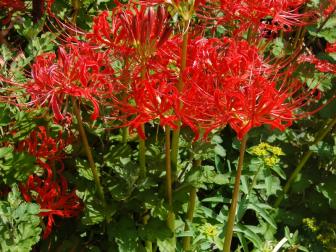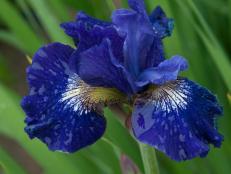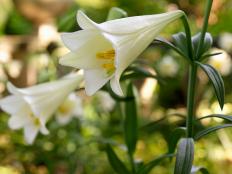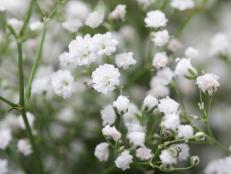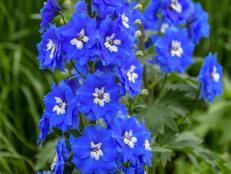Learn How to Plant and Grow Spider Lily
These old-fashioned favorites bring gorgeous blooms when other flowers have faded, popping up like magic in late summer.

Spider lilies get their name from blooms that look, well, a bit spider-like. These perennials produce a cluster of elegantly curled petals with exceptionally long stamens that splay outward atop a long, naked stem. Oddly, spider lilies have no foliage when they bloom. Their leaves die back early in the summer, and you see no more sign of the plant until fall when stalks of colorful blooms emerge out of nowhere from the bare ground.

Shutterstock/Phototenki
Red Spider Lily (Lycoris radiata) grows umbrels of four to six coral-red flowers festooned with extremely long stamens that curl upward. Magical looking flowers grow to 24 inches tall.
The striking, seemingly magical blooms in red, orange, yellow or white add color to the landscape in a late summer or early fall garden, when most other flowers have stopped blooming. The blooms last for about two weeks.
Spider lilies grow from bulbs. They don’t need much help to thrive, so plant them and forget them, and they’ll multiply into an impressive stand of flowers over the years. Red spider lily (Lycoris radiata) is an heirloom in Southern gardens, a classic passalong plant that can be found growing in old gardens, yards and cemeteries generations after they were planted. In the Coastal South, red spider lilies are also called hurricane lilies because they bloom around the season that hurricanes roll in off the Gulf.
18 Favorite Bulb Flowers for Year-Round Color 19 Photos
Planting a variety of bulbs — including red spider lily — can create a year-long parade of color in your garden.
Spider lilies are enduring perennials, and only need to be divided every seven years or so. They're resistant to diseases and pests, and deer do not find them tasty. Birds, bees and butterflies love them, so a patch of spider lilies will draw lovely winged creatures to your garden.
Of the dozen-or-so species in cultivation, most are native to China or Japan. They’re in the amaryllis family. There are other flowers called spider lilies that are native to North America also in the amaryllis family, but they’re in the genus Hymenocallis. A similarly named plant, the spider flower (Cleome), is not related to the spider lily but is actually an annual in the caper family. Go figure.
Botanical name: Lycoris
Common Names: Spider Lily, Hurricane Lily, Magic Lilies, Surprise Lilies
Hardiness Zones: 7 to 11
Bloom Time: Late Summer to Early Fall
Planting Spider Lilies
- Grow spider lilies from bulbs. Each bulb will produce one to four flower stems.
- Fall or early spring is the best times to plant spider lily bulbs.
- You’ll get the most flowers if you plant them in full sun to partial shade.
Spider lilies like rich, moist but well-drained, slightly alkaline soil that dries out between rains. - Dig a hole and plant spider lily bulbs pointed end up. Place them so their necks are at just above the soil surface.
- Don’t bury the top of the bulb or it may not flower.
- Space them 12 inches apart.
Growing and Caring for Spider Lilies
- Once you plant bulbs, water lightly and regularly until growth emerges from the bulb.
- Continue watering moderately during the growing season.
- When the leaves start to wither in the summer, withhold water and let the soil go dry.
- Remove the leaves once they’re yellow and withered.
- Rains will take care of the rest of your work. Your lilies will bloom after a late summer rain, popping up out of nowhere, like magic.
- Divide and separate lily bulbs every seven years or so to keep them from crowding.
Propagation
- Dig up divisions of spider lilies after bloom to start a new plant.
- Expect to wait a season or two before getting lily blooms after they’ve been transplanted. They don’t like having their roots disturbed.
Pests and Problems
- Spider lilies are pest- and disease-resistant, but root rot can get them if they’re grown in soil that’s too wet.
- Too much shade will prevent them from blooming.
Recommended Varieties of Spider Lily
Red Spider Lily (Lycoris radiata) is the classic passalong plant of heirloom gardens in the South and Midwest. It grows umbrels of four to six coral-red flowers festooned with extremely long stamens that curl upward. Magical looking flowers grow to 24 inches tall. In tropical climates, red spider lilies put out foliage in the fall and bloom all winter. It prefers partial shade and cannot tolerate direct sun.
White Spider Lily (Lycoris albiflora) has white flowers in clusters of six to eight blooms with long, curved stamens. Each flower has a creamy pink stripe in its center. White spider lily makes an excellent cut flower.
Naked Ladies (Lycoris squamigera) produces strap-like leaves in the spring that disappear in the summer. In the fall, trumpet-shaped, lilac-pink flowers bloom atop 18-inch-tall stalks that pop out of the ground.
Garden Uses
- Plant in masses in shrub and perennial borders.
- Line a partly shaded path with them.
- Use them to naturalize areas between a lawn and a woodland.
- Spider lilies add texture as well as color, so pair them with foliage plants.
- Plant them among spring-flowering bulbs so the bed has color in the fall.
- If you live outside of spider lilies' hardiness range, grow them in containers.
- They make a great thriller plant in a container recipe.
- Plant them in a cutting garden because they look great in bouquets.






